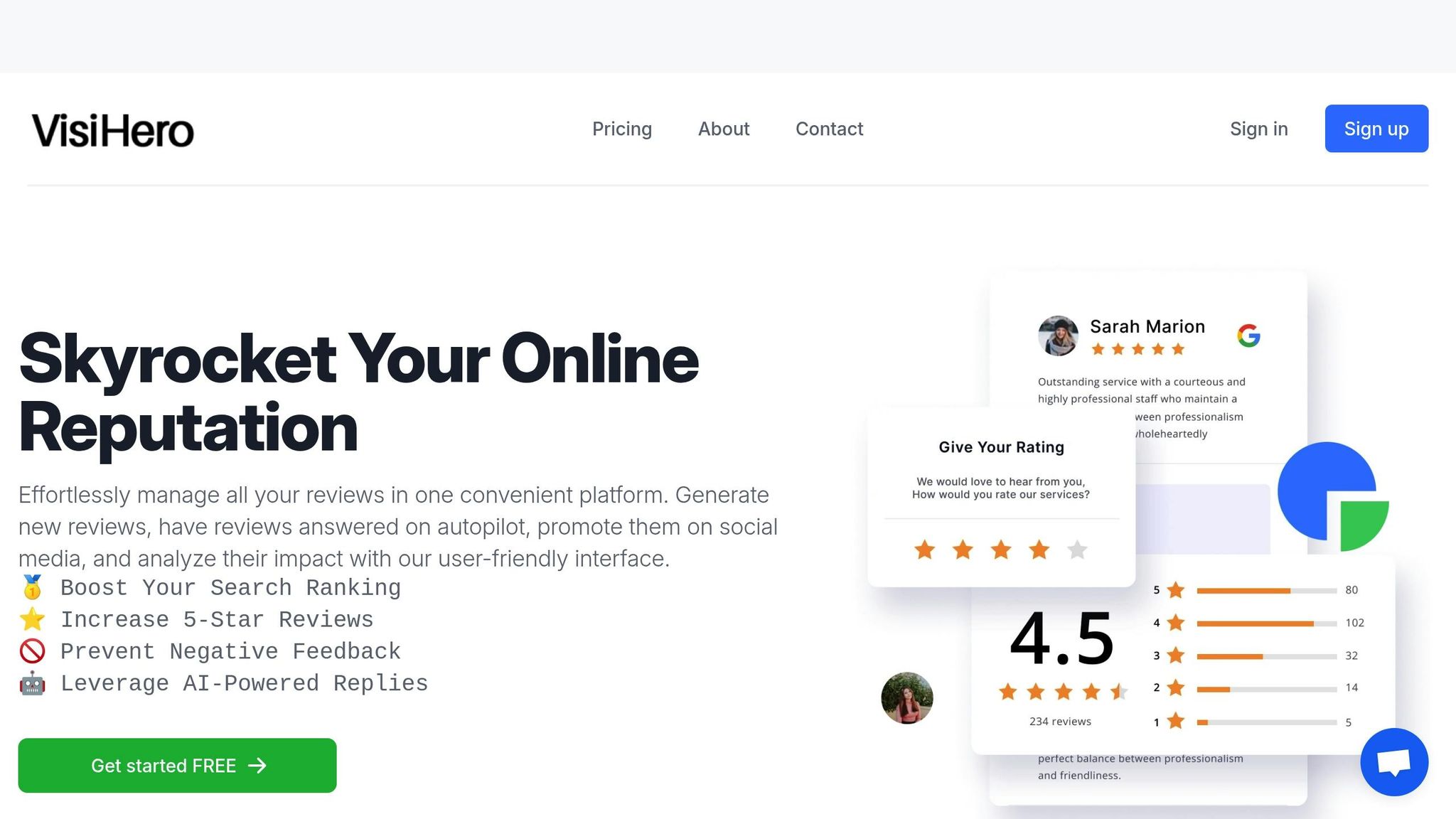Want to boost sales? Start managing your reviews. Businesses that effectively handle reviews can see an 18% revenue increase on average. Here’s why it matters:
- Negative reviews hurt sales: Just 1 bad review can turn away 21.9% of customers. With 4 bad reviews, that number jumps to 69.9%.
- Positive reviews drive growth: Good reviews can improve conversion rates by up to 270%. Restaurants, for example, see a 5–9% revenue boost for each additional Yelp star.
Key Metrics to Track:
- Average Order Value (AOV): Higher ratings often mean customers spend more.
- Conversion Rate: Positive reviews = higher purchase rates.
- Customer Lifetime Value (CLV): Happy customers buy again.
- Review Sentiment Analysis: Understand customer feedback trends to improve satisfaction.
Tools to Simplify Review Management:
Platforms like VisiHero help track reviews, analyze sentiment, and calculate ROI with features like:
- AI-powered responses to reviews.
- Automated review requests via email/SMS.
- Real-time analytics to connect reviews to sales.
Bottom Line: Managing reviews isn’t just about reputation – it’s about revenue. Start tracking, responding, and leveraging reviews to grow your business.
How to Calculate the ROI of Online Reputation Management
Measuring Review Management Success
To gauge how your review strategy impacts revenue, keep an eye on these key performance indicators (KPIs):
Core Business Metrics
- Average Order Value (AOV): Check how much customers spend on average per order. Positive reviews might encourage them to spend more.
- Conversion Rate: Only 2.86% of eCommerce visits typically lead to a purchase. Track how review volume and ratings influence this percentage.
- Customer Acquisition Cost (CAC): Calculate the cost of acquiring new customers through review-driven campaigns, factoring in incentives and promotions.
- Customer Lifetime Value (CLV): See how managing reviews affects customer loyalty and how often they return to make purchases.
These KPIs provide a starting point for evaluating changes after implementing review strategies.
Review Performance Metrics
- Review Volume and Velocity: Monitor the total number of reviews and how quickly new ones are coming in.
- Sentiment Analysis: Dive into customer feedback to identify what they love, recurring concerns, and which product features stand out.
Once you’ve got these metrics, link them to your revenue outcomes.
Connecting Reviews to Sales
- Social Proof Impact: With 74% of consumers relying on their social networks for purchasing decisions, track how often reviews are shared or interacted with on social platforms.
- Review-Driven Sales Tracking: Measure the number of leads generated by reviews, their conversion rates, and the revenue they bring in.
- Customer Feedback Loop: Quickly address complaints to avoid losing revenue and protect your brand’s reputation.
Calculating Review Management Returns
To determine ROI, factor in revenue increases and cost savings achieved through review management. Use the metrics from the previous section as your starting point.
Measuring Revenue Growth
- Compare sales, conversion rates, and average order values before and after implementing review management. Subtract the costs of implementation to find the additional revenue generated.
Cutting Operating Costs
- Reviews can help reduce customer support inquiries, lower return rates, and improve organic visibility – leading to less reliance on paid advertising.
Leveraging VisiHero Analytics

- Use VisiHero’s dashboard to link revenue directly to review channels, monitor response rates and sentiment, and create automated ROI reports.
Customize dashboards to highlight the metrics that matter most to your business. This allows you to connect review performance with sales results effectively. Dive deeper into platform tools that simplify ROI tracking.
sbb-itb-0a038f8
Review Management Platform Features
A review management platform should include tools that help track and boost ROI. These features should align with the KPIs and ROI metrics discussed earlier.
Core Platform Capabilities
To support the metrics outlined earlier, your platform should include:
- AI-powered review responses for consistent and personalized interactions
- Automated review requests via email and SMS, achieving over 20% positive review rates
- Sentiment analysis to identify patterns and issues in feedback
- Multi-platform integration to monitor reviews across 200+ websites
| Feature | Business Impact |
|---|---|
| AI-Powered Responses | 88% of consumers are more likely to use businesses that reply to reviews |
| Multi-Platform Monitoring | Simplifies tracking reviews across 200+ sites from a single dashboard |
| Automated Review Requests | Over 20% of customers asked to leave a review provide positive feedback |
| Sentiment Analysis | Highlights trends that influence customer satisfaction |
VisiHero brings all these features together in one streamlined dashboard. Let’s dive into its ROI-focused tools.
VisiHero’s ROI Tools
VisiHero extends its core features with advanced tools designed to track ROI:
- Real-time analytics to connect reviews with sales performance
- Custom widgets and SEO snippets to highlight positive feedback on your website
- Trackable QR codes and customizable email templates to drive review collection
- Video review requests and shareable templates to boost visibility on social platforms
Selecting Your VisiHero Plan
Pick a plan that suits your business size and review management goals:
| Plan | Monthly Cost | Ideal For | Features Included |
|---|---|---|---|
| Check-In Tier | $0.00 | Small businesses | AI review responses, 100 email/SMS requests per month |
| Five-Star Focus | $99.00 | Growing companies | Manage 5 locations, 300 email/SMS requests per month |
| Reputation Concierge | $399.00 | Multi-location enterprises | Manage 20 locations, 1,000 email/SMS requests per month |
Improving Review Management Results
Use VisiHero’s automated tools – email, SMS, and display features – to increase your review count, improve response rates, and enhance visibility.
Getting More Reviews
VisiHero’s email and SMS campaigns can help you gather more customer feedback. On average, prompted reviews score 4.34 stars compared to 3.89 for unprompted ones.
Here’s how to collect more reviews effectively:
- Email: Personalize your messages, keep them short, and send them in the afternoon or shortly after a purchase. These emails typically have open rates of 40–50%.
- SMS: Write concise and direct texts with clear links for leaving reviews. Text messages boast a 98% open rate, with 90% read within three minutes.
- Point of Sale: Provide customers with a device at checkout to leave feedback immediately, without needing to log into their accounts.
- Mobile Optimization: Ensure your review request and submission pages work well on smartphones and tablets, as 56% of reviews come from mobile devices.
"Asking for reviews from customers is one of today’s most powerful customer acquisition and retention strategies." – ReviewTrackers
Review Response Guidelines
Responding to reviews shows customers you value their input and helps build loyalty:
- Positive Reviews: Respond quickly to show appreciation.
- Negative Reviews: Address concerns professionally to rebuild trust.
- Follow-Up: Personalize your replies and focus on resolving issues.
Maximizing Review Visibility
Once you’ve collected a solid base of reviews, make them work harder for your business:
- Share glowing reviews on your social media platforms to expand your reach.
- Feature standout feedback in marketing materials to strengthen credibility.
- Organize reviews for easy browsing – 7% of consumers need to read at least 20 reviews to feel confident about a company.
Next Steps for Review Management
Once you’ve put the strategies into action, here’s how you can measure ROI and ensure ongoing support:
-
Calculate Lost Revenue
Use the formula: Y = X / (100 − X), where X represents the percentage of customers lost. For example, if 44.1% of customers are lost, Y ≈ 0.79. This means that for every $1.00 earned, $0.79 was lost. -
Connect Reviews to Revenue
Utilize tools like VisiHero’s analytics dashboard to link review platforms to sales data, monitor changes in key performance indicators (KPIs), and generate automated ROI reports. -
Track Key Metrics
Establish goals for metrics like conversion rate improvements, sentiment trends, and monthly review volume. Use automated tools to send review requests and manage responses to keep momentum going.
These steps will help you allocate budgets wisely, prove financial results, and secure continued investment in review management.
FAQs
How can I measure the impact of managing customer reviews on my business’s revenue?
To measure how your review management efforts affect revenue, start by analyzing key metrics like the number of leads generated from positive reviews and their conversion rates. Estimate how much these customers spend on average and compare this to the cost of acquiring and managing reviews.
Customer reviews build trust and credibility, which can directly influence purchasing decisions. By tracking these metrics, you can clearly see how effective review management contributes to your sales growth and overall ROI.
How can I effectively encourage customers to leave more positive reviews?
To encourage more positive reviews, start by delivering exceptional customer experiences that leave a lasting impression. Proactively ask satisfied customers for feedback, especially after a positive interaction or successful purchase. A simple, polite request can go a long way.
Make the review process quick and effortless by providing clear instructions or direct links to review platforms. You can also offer gentle incentives, like exclusive discounts or loyalty points, to motivate participation (while staying compliant with platform guidelines).
Finally, show customers you value their input by responding to reviews – both positive and negative. Acknowledging positive feedback builds trust and strengthens relationships, while addressing concerns demonstrates your commitment to continuous improvement.
What’s the best way to handle negative reviews without hurting my sales?
Negative reviews don’t have to harm your sales if you handle them the right way. A thoughtful response can even build trust and show your commitment to customer satisfaction.
Start by responding quickly and professionally. Acknowledge the issue, apologize if necessary, and offer a solution. This demonstrates that you value feedback and are willing to make things right. Whenever possible, take the conversation offline – provide contact details or invite the reviewer to discuss their concerns privately. This shows you’re serious about resolving the issue and keeps the details of the resolution out of public view.
Lastly, use the feedback as an opportunity to improve. Negative reviews can highlight areas for growth, helping you refine your products or services to better meet customer expectations. By addressing concerns constructively, you not only protect your sales but also strengthen your brand’s reputation.
